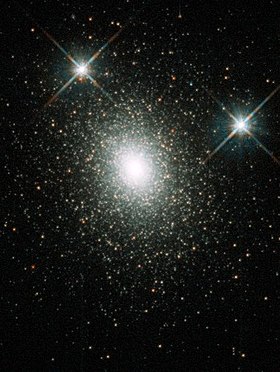Mayall II
| Mayall II | |
|---|---|
 Hubble Telescope image of Mayall II, colour picture assembled from separate images taken in visible and near-infrared wavelengths in July 1994. Credit: Michael Rich, Kenneth Mighell, and James D. Neill (Columbia University), and Wendy Freedman (Carnegie Observatories) and NASA | |
| Observation data (J2000 epoch) | |
| Constellation | Andromeda |
| Right ascension | 00h 32m 46.51s[1] |
| Declination | +39° 34′ 39.7″[1] |
| Distance | 2.52 ± 0.14 Mly (770 ± 40 kpc) |
Apparent magnitude (V) | +13.81[1] |
| Physical characteristics | |
| Mass | 1×107[2] M☉ (2×1037 kg) |
| Radius | 21.2 ± 1.0 ly (6.5 ± 0.3 pc) (Half light radius rh) and tidal radius 263.2 ± 12.7 ly (80.7 ± 3.9 pc) [3] |
| Estimated age | ~ 12 Gyr [2] |
| Other designations | SKHB 1, HBK 0-1[1] |
Mayall II, also known as NGC-224-G1, SKHB 1, GSC 2788:2139, HBK 0-1, M31GC J003247+393440 or Andromeda's Cluster, is a globular cluster orbiting M31, the Andromeda Galaxy.
It is located 130,000 light-years (40 kpc)[3] from the Andromeda Galaxy's galactic core, and is the brightest[3] (by absolute magnitude) globular cluster in the Local Group, having an apparent magnitude of 13.81 in V band. Mayall II is considered to have twice the mass of Omega Centauri, and may contain a central, intermediate-mass (∼ 2×104M⊙) black hole.[3]
It was first identified as a possible globular cluster by American astronomers Nicholas Mayall and Olin J. Eggen in 1953 using a Palomar 48-inch (1.2 m) Schmidt plate exposed in 1948.[3]
Because of the widespread distribution of metallicity, indicating multiple star generations and a large stellar creation period, many contend that it is not a true globular cluster, but is actually the galactic core that remains of a dwarf galaxy consumed by Andromeda.[3][4]
Contents
1 Origin of names
2 See also
3 References
4 External links
Origin of names
- Mayall II is named after Nicholas U. Mayall, who, with Olin J. Eggen, discovered it in 1953.
- SKHB 1 is named for Wallace L. W. Sargent, Charles T. Kowal, F. D. A. Hartwick, and Sidney van den Bergh. They also named it G1 in 1977.
- HBK 0-1 is named for John Huchra, J. P. Brodie, and S. M. Kent in 1991.
See also
- Messier 54
- Omega Centauri
- Mayall's Object
References
^ abcd "NAME Mayall II". SIMBAD. Centre de données astronomiques de Strasbourg. Retrieved 2009-09-13..mw-parser-output cite.citation{font-style:inherit}.mw-parser-output .citation q{quotes:"""""""'""'"}.mw-parser-output .citation .cs1-lock-free a{background:url("//upload.wikimedia.org/wikipedia/commons/thumb/6/65/Lock-green.svg/9px-Lock-green.svg.png")no-repeat;background-position:right .1em center}.mw-parser-output .citation .cs1-lock-limited a,.mw-parser-output .citation .cs1-lock-registration a{background:url("//upload.wikimedia.org/wikipedia/commons/thumb/d/d6/Lock-gray-alt-2.svg/9px-Lock-gray-alt-2.svg.png")no-repeat;background-position:right .1em center}.mw-parser-output .citation .cs1-lock-subscription a{background:url("//upload.wikimedia.org/wikipedia/commons/thumb/a/aa/Lock-red-alt-2.svg/9px-Lock-red-alt-2.svg.png")no-repeat;background-position:right .1em center}.mw-parser-output .cs1-subscription,.mw-parser-output .cs1-registration{color:#555}.mw-parser-output .cs1-subscription span,.mw-parser-output .cs1-registration span{border-bottom:1px dotted;cursor:help}.mw-parser-output .cs1-ws-icon a{background:url("//upload.wikimedia.org/wikipedia/commons/thumb/4/4c/Wikisource-logo.svg/12px-Wikisource-logo.svg.png")no-repeat;background-position:right .1em center}.mw-parser-output code.cs1-code{color:inherit;background:inherit;border:inherit;padding:inherit}.mw-parser-output .cs1-hidden-error{display:none;font-size:100%}.mw-parser-output .cs1-visible-error{font-size:100%}.mw-parser-output .cs1-maint{display:none;color:#33aa33;margin-left:0.3em}.mw-parser-output .cs1-subscription,.mw-parser-output .cs1-registration,.mw-parser-output .cs1-format{font-size:95%}.mw-parser-output .cs1-kern-left,.mw-parser-output .cs1-kern-wl-left{padding-left:0.2em}.mw-parser-output .cs1-kern-right,.mw-parser-output .cs1-kern-wl-right{padding-right:0.2em}
^ ab Ma, Jun; de Grijs, Richard; Fan, Zhou; Rey, Soo-Chang; Wu, Zhen-Yu; Zhou, Xu; Wu, Jiang-Hua; Jiang, Zhao-Ji; Chen, Jian-Sheng; Lee, Kyungsook; Sohn, Sangmo Tony (June 2009). "RESEARCH PAPER: Old stellar population synthesis: new age and mass estimates for Mayall II = G1". Research in Astronomy and Astrophysics. 9 (6): 641–652. arXiv:0904.0674. Bibcode:2009RAA.....9..641M. doi:10.1088/1674-4527/9/6/003.
^ abcdef Ma, J.; de Grijs, R.; Chen, D.; van den Bergh, S.; Fan, Z.; Wu, Z.; Wu, H.; Zhou, X.; Wu, J.; Jiang, Z.; Chen, J. (April 2007). "Structural parameters of Mayall II = G1 in M31". Monthly Notices of the Royal Astronomical Society. 376 (4): 1621–1629. arXiv:astro-ph/0702012. Bibcode:2007MNRAS.376.1621M. doi:10.1111/j.1365-2966.2007.11573.x.
^ Meylan, G.; Sarajedini, A.; Jablonka, P.; Djorgovski, S. G.; Bridges, T.; Rich, R. M. (August 2001). "Mayall II=G1 in M31: Giant Globular Cluster or Core of a Dwarf Elliptical Galaxy?". The Astronomical Journal. 122 (2): 830–841. arXiv:astro-ph/0105013. Bibcode:2001AJ....122..830M. doi:10.1086/321166.
External links
- Astrophysical Journal, Vol. 370, p. 495–504
- Publications of the Astronomical Society of the Pacific, Vol. 65, No. 382, p. 24–29
- Astronomical Journal, vol. 82, p. 947–953
- NightSkyInfo.com: Mayall II
